The four site-specific mosaics at Palmers Green Station were commissioned by Palmers Green Action Team and funded by Govia Thameslink Railway from their Passenger Benefit Fund. The themes of the mosaics reflect the green spaces of the area. The project was initially planned to be made with the local community but due to the pandemic the whole process was delayed and eventually the mosaics were made by Alex with the help of Tamara Froud and a few of the children at Broomfield School who were attending classes towards the end of the Summer term 2020.
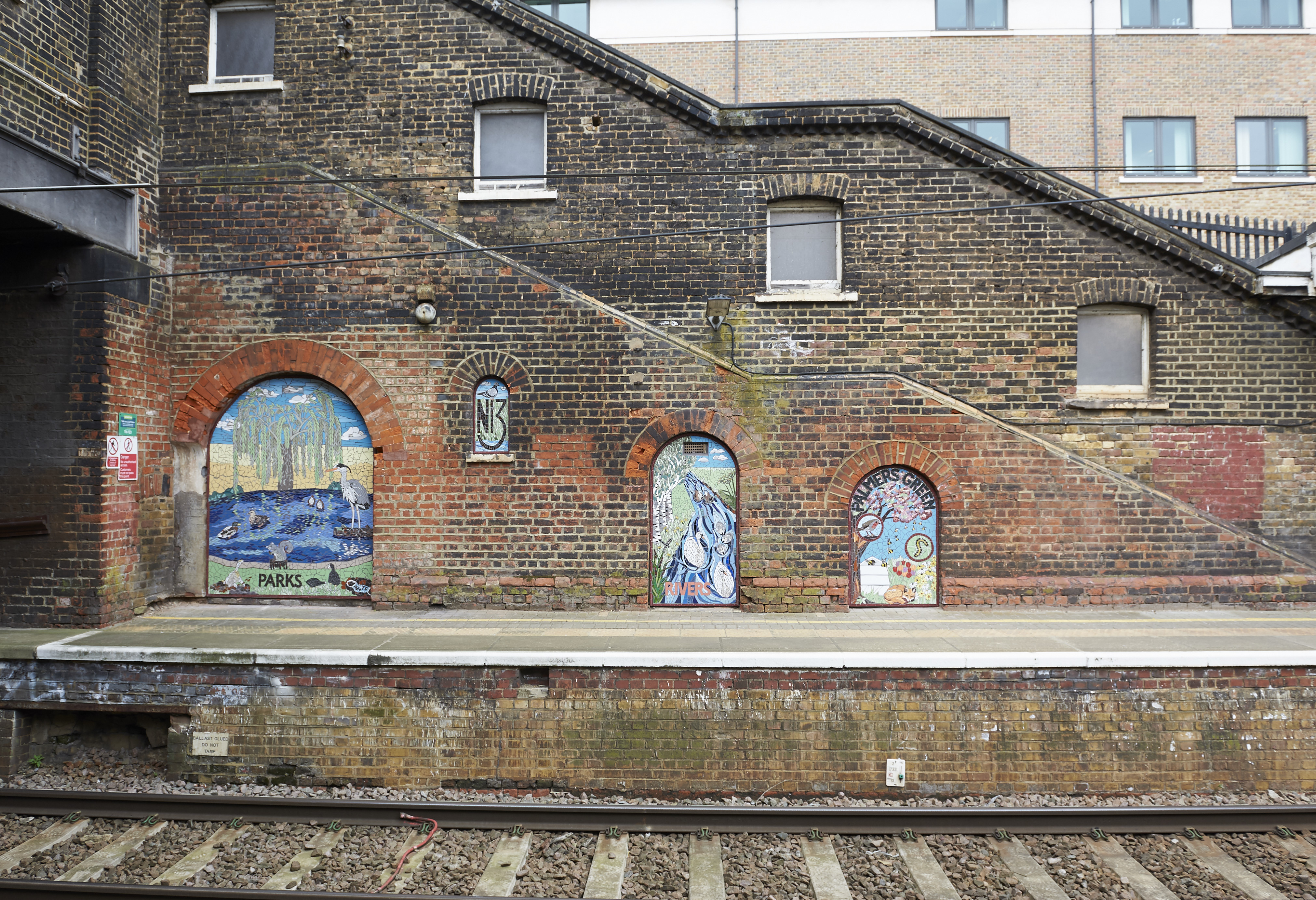

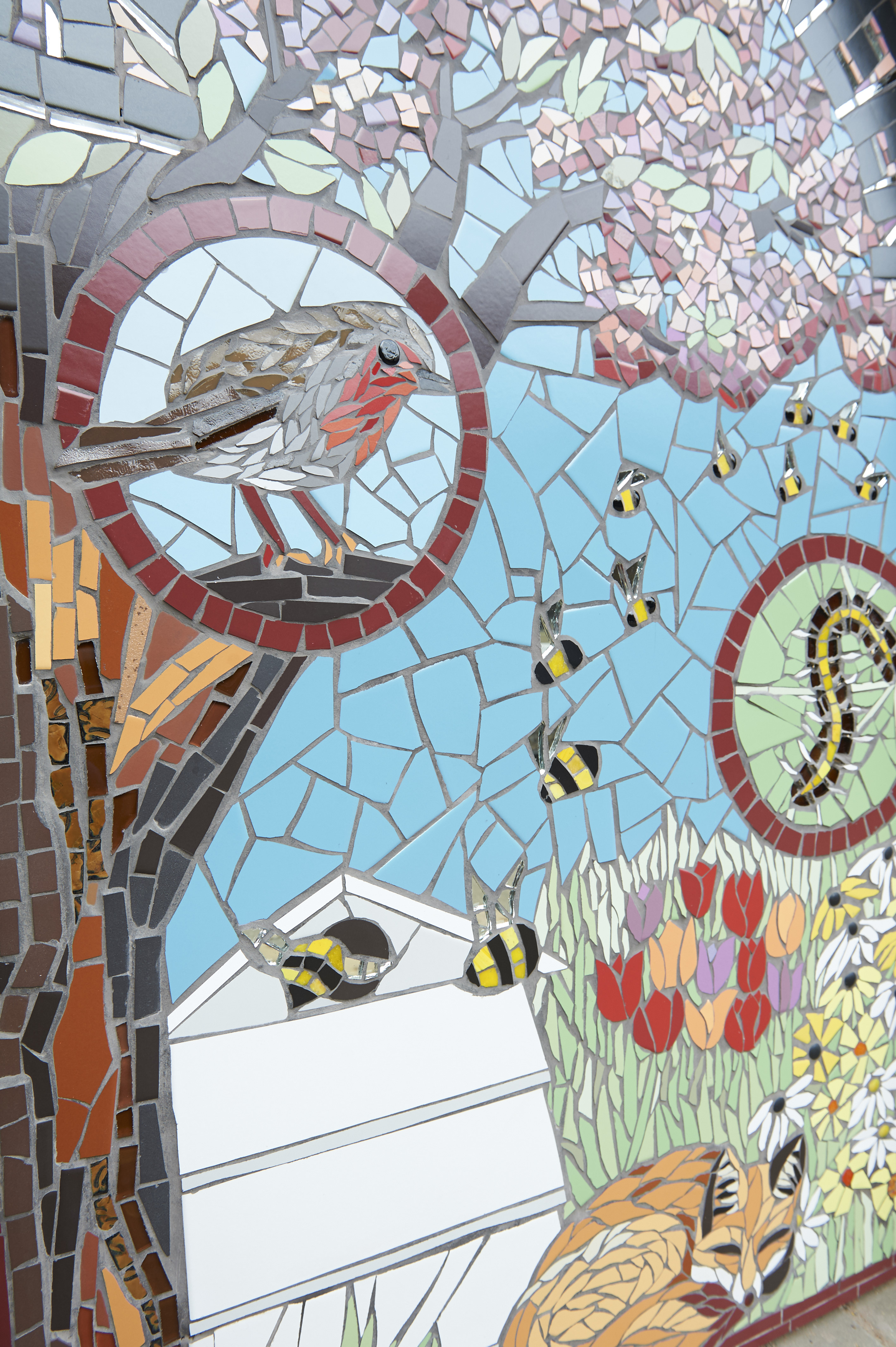

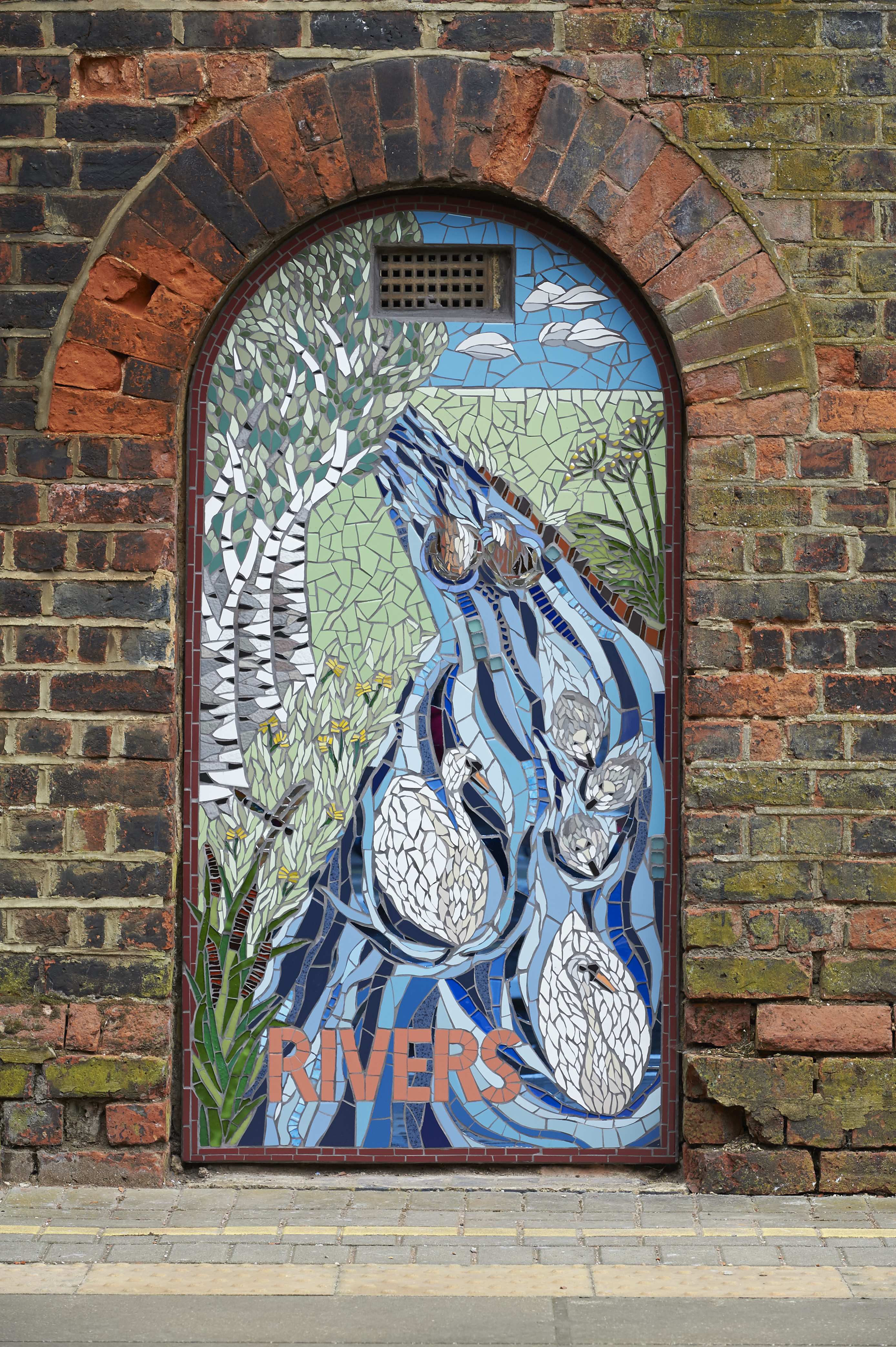
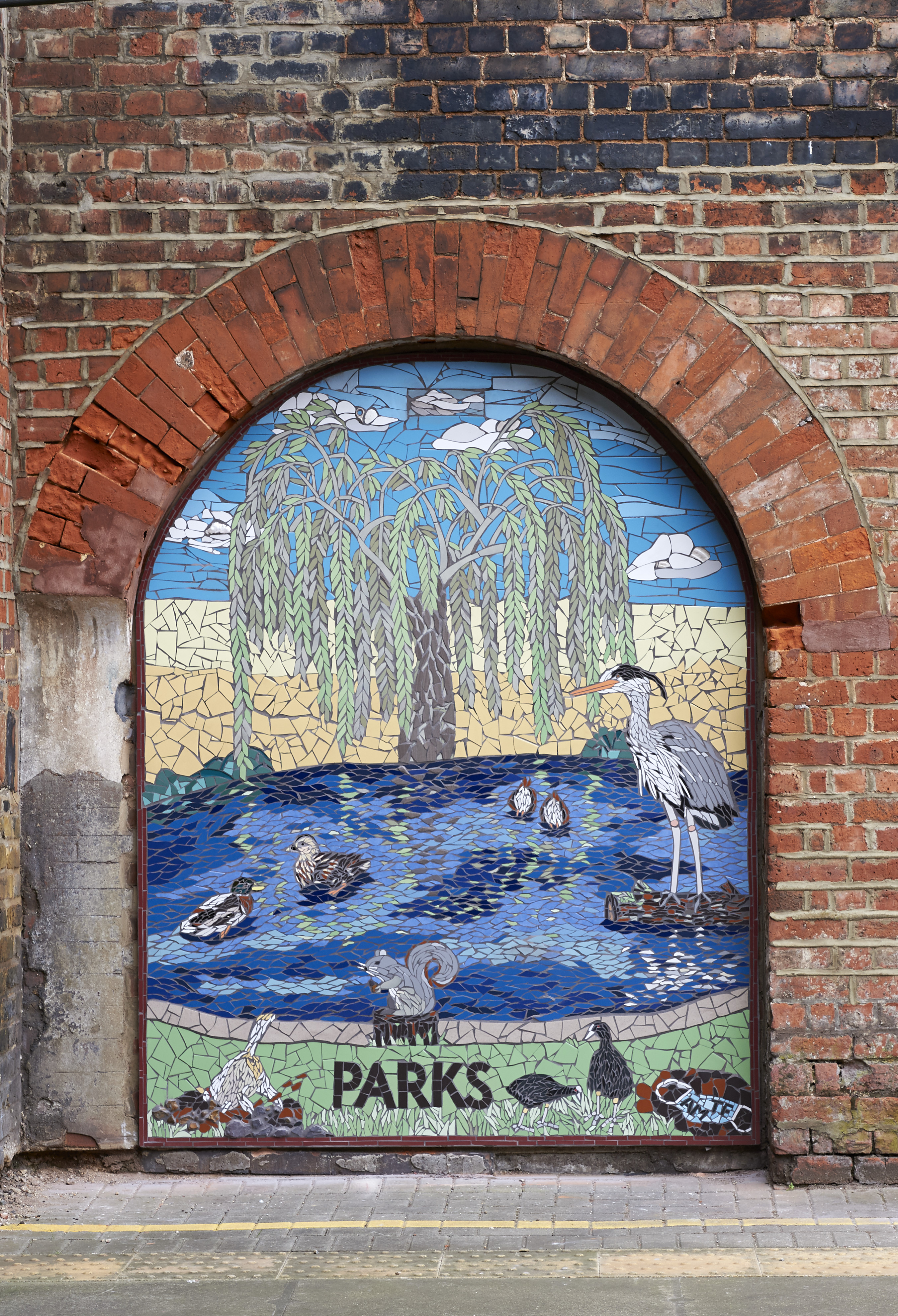

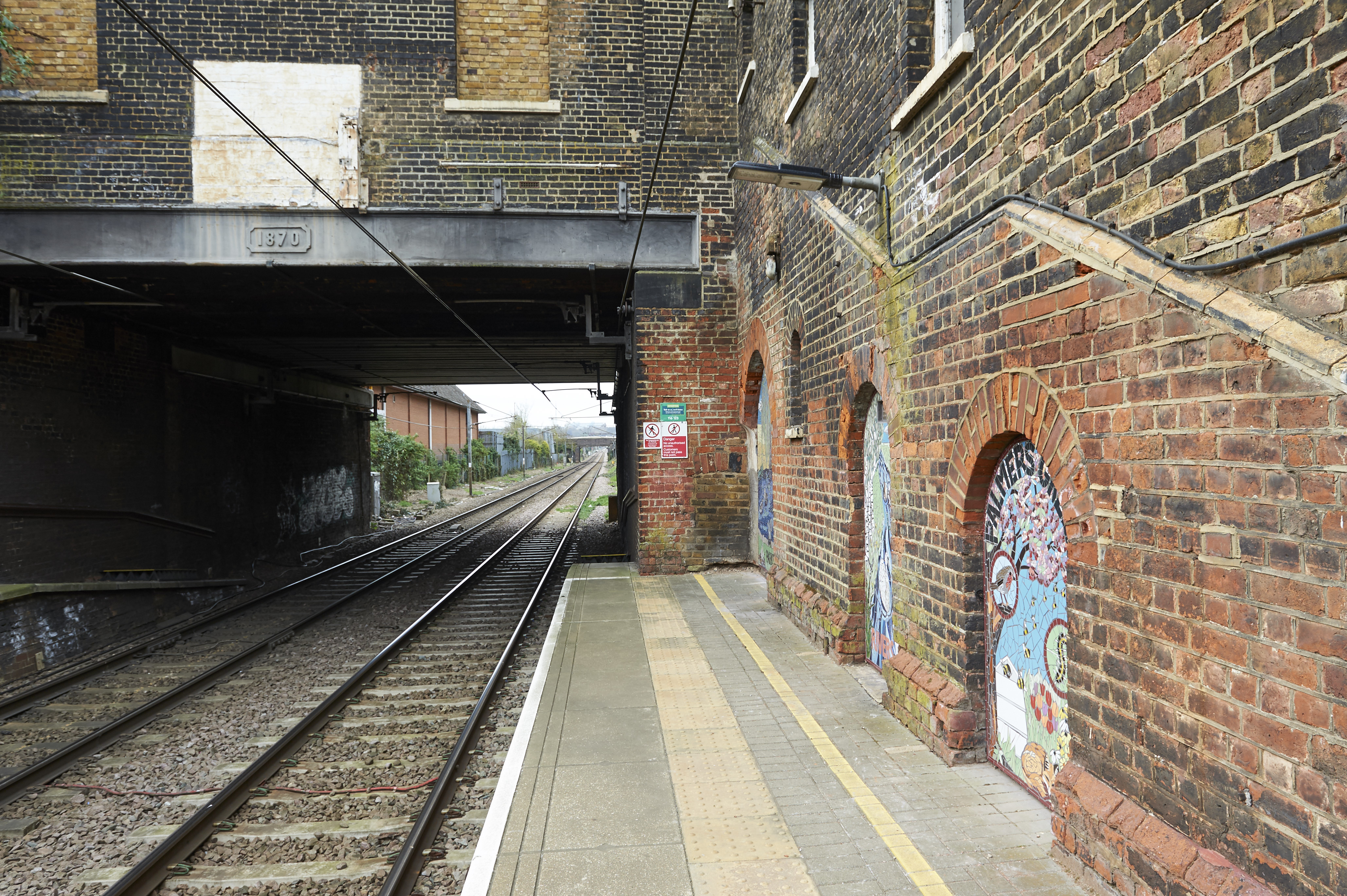
Here’s the full story:
Palmers Green is a suburb of North London. There has been a railway station there since 1871 which takes passengers to and from the centre of London. A few days before Christmas in December 2019 I was approached by a group of local volunteers, the Palmers Green Action Team (PGAT) who had received some money from the train operators Govia Thameslink Railway, via their Passenger Benefit Fund. This was to be put towards improving the appearance of the station, which is predominantly open air and covered in white boards with information and advertising.
The idea of creating a mosaic or series of mosaics was warmly received and another site visit in January secured the four arches on the North bound platform for this purpose. I particularly like this spot as it is away from the clutter of the rest of the station and can be best viewed from the South bound platform, where people will be waiting for the trains into the City.
The theme of the mosaics was to be the ‘Green’ in Palmers Green. Although there are four arches, they are not similar in size of spacing, so using the Four Seasons or having any theme that required equal emphasis was not going to be possible. Instead, I looked to the nature of the local area. I grew up and went to primary school in Palmers Green and I still live nearby, so I drew on this knowledge as I knew that it would form the basis of a shared experience of the area. There are many parks nearby and two water ways, the combination of which has resulted in beautiful trees and an abundance of bird life. There are also a lot of gardens, so the themes became Parks, Rivers and Gardens and the fourth mosaic, which is much smaller than the others, is the post code for the area. I looked at vintage posters that advertised the railway from when it was opened through to the 20th Century and I drew on them for the colour scheme and style of the mosaics.
PGAT were keen for the project to involve the local community, so I contacted the local schools and mosque to work out a series of workshops to get people making.
I had by this point asked Tamara Froud to help me with the making and installing. We know each other through our work on the BAMM Committee. With workshops lined up and a short lead time we started preparing the design for the Gardens mosaic and getting the tiles ready.
Then everything stopped.
The first workshop had been booked for March 21st and we went into lockdown without a single tile being stuck down.
It wasn’t until early June that we were able to meet up again to start work on the project. In the interim I had worked on the designs for the Rivers and Post Code mosaics.
We decided we had to start working on the mosaics because even without our community to engage with we still had a deadline for completion. I contact the schools again at this point, but they were nearly all home schooling via zoom, which was what we were expecting under the circumstances. We then had a bit of luck as an art teacher, Aimee Morris, from Broomfield Secondary School contacted one of my local suppliers to order some materials. Knowing I was working on the mosaics, they put me in contact with her. I think it is fair to say that never has an offer of a workshop been answered so quickly! Broomfield had a significant number of key workers’ children who were still attending school. We organised two days in the school before the end of the summer term. Tamara and I went back to the Gardens mosaic and worked on this with the children. As a special thanks to the school we incorporated a beehive in the design which features on the school badge. It was a joy to work with them.
After this the two of us worked on the mosaics, moving into a bigger studio to accommodate the ever-increasing metres of mosaic – approximately 10m2 in total. We worked directly onto mesh with cement-based adhesive and all the materials had to be frost proof. Our final flourish was to include our initials on a discarded mask in the bottom right hand corner of the ‘Parks’ mosaic as a permanent reminder of the time in which the mosaics were made.
We stuck the mosaics onto boards rather than directly onto the station walls for two reasons. Firstly, in early discussions with the technical team at Govia Thameslink they expressed their reluctance at allowing us to stick the mosaics directly onto the walls because of resulting damage if they ever needed to be removed. Secondly, they informed us that we would have to install at night and so as much prep as possible had to be done beforehand, including grouting them.
This turned out to be very good advice. We finally finished the mosaic in January 2021 and then watched the temperature drop well below 6 degrees, the temperature at which cement will cure. By mid March we were all slightly anxious about the delay. Then I received an email from Govia asking me if the mosaics could be installed temporarily as the station had been designated as ‘step free’ from 2023 and it was likely that the wall they were being mounted on would have to come down.
The mosaics were therefore installed overnight using bolts and grip glue. We took photos of where the bolts were placed so that when we come to take them down we know which tiles we have to remove to access them.
Why put them up if they have to come down? Tamara and I had no doubt this was the correct course of action. Now they are up, the mosaics have a legacy and the Railway has a responsibility to look after them. I have to say that the railway’s technical team were so impressed by the standard of the work and our professionalism during the installation that the work is already really valued. The very next day after our night shift I wrote a detailed document about taking the mosaics down, storing them, making good and re installing them and my expectation of being included in the planning of the new platform to establish a suitable and permanent place for the mosaics.
The railway also have the local community to answer to. PGAT and the people of Palmers Green are delighted with their new public art commission and look forward to seeing it every day on their journeys to and from home.
Materials used: Cinca tiles, Laticrete adhesive and grout, Marmox boards with generic fixings
With thanks to Govia Thameslink Passenger Benefit Fund; Palmers Green Action Team, Broomfield School, Andrew McHallam (for extra workspace) and Etienne Guimard (for help with installing) all the team at Tate Solutions.
All photographs courtesy of Amanda Eatwell (amandaeatwell.com)